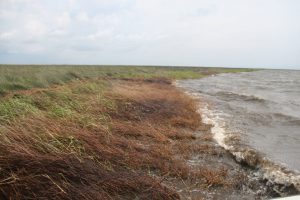Eight-Year Study Quantifies How Oiling is a Continuing Stressor on the Marsh Ecosystem
– AUGUST 29, 2019
Scientists measured changes in oil quantity and quality in 1,200+ samples collected over eight years at locations that Deepwater Horizon affected – the Gulf of Mexico continental shelf, estuarine waters, and marsh sediments. Total aromatic concentrations in offshore waters peaked in late summer 2010 (100 times above May 2010 values) and returned five years later. Monthly measures of aromatic concentrations in estuarine waters were proportional to those 1 km from the estuary entrance, but 15%-35% lower. The concentrations in marsh sediments peaked in fall 2011 (1,000 times above May 2010 levels) then dropped to 10 times higher over 8 years. The initial oiling at the marsh edge gradually affected the entire marsh within two years, suggesting that the total area oiled was larger than the visible initial oil distribution when the spill first occurred. The authors estimated that marsh sediments will retain high levels throughout this century.
The authors published their findings in Environmental Pollution: Oiling of the continental shelf and coastal marshes over eight years after the 2010 Deepwater Horizon oil spill.
The Deepwater Horizon incident created a singularly massive oil spill delivered within the background of oil contamination from the Mississippi River, atmosphere, releases from ships, historic and recent oil production platforms and infrastructure, and natural seeps. Determining ecosystem damage values from this 2010 event requires knowing: 1) how much of the original oil and oil residue reached the continental shelf, entered the estuaries, and were deposited in marshes; and 2) if the amounts persisted or changed.
This study’s team linked oil residues to Deepwater Horizon by visually paring chromatographic profiles of biomarker compounds with those in MC252 source oil. They found that petroleum constituents in offshore water samples were temporally synchronous with the residual oil in the Barataria Bay estuary, implying transport and mixing. The chemical signature of the oil residues offshore reflected the aerobic conditions and water-soluble tendencies of the dissolved components, whereas the anaerobic marsh sediments retained the heavier molecular oil components.
“Oil that’s spilled offshore comes inshore, and some of those oil residues will be re-suspended and distributed in sediments throughout the estuary,” said study author Eugene Turner. “Recovery to pre-spill concentrations takes years in offshore waters; but oil spills leave a permanent legacy in the marsh. The initial oil at the marsh edge gradually smeared across the entire marsh over two years, blurring the distinction between oiled and unoiled marsh sites. Therefore, defining sites as ‘oiled’ or ‘not oiled’ at the beginning of the oil intrusion was not valid after 18 months without an analytical confirmation.”
The authors noted that the remaining oil residues can continue to affect organisms through complex, subtle interactions in offshore and inshore ecosystems, including food webs and marsh vegetation, and accelerate shoreline erosion. Studies that improve understanding of oil spill impacts also point to the value in decisions for quick containment, effective damage evaluation, and appropriate mitigation.
The study data are available at the Gulf of Mexico Research Initiative Information & Data Cooperative (GRIIDC) at DOI:10.7266/N7028PZZ, DOI:10.7266/n7-czff-sm91, DOI:10.7266/n7-tph2-3e25, and DOI:10.7266/n7-kdeg-nj49.
The study’s authors are R. Eugene Turner, Nancy N. Rabalais, Edward B. Overton, Buffy M. Meyer, Giovanna McClenachan, Erick M. Swenson, Mark Besonen, Michael L. Parsons, and Jeffrey Zingre.
By Nilde Maggie Dannreuther. Contact maggied@ngi.msstate.edu with questions or comments.
************
This research was made possible in part by a grant from the Gulf of Mexico Research Initiative (GoMRI) to the Coastal Waters Consortium III (CWC III). Other support included an NSF Rapid Grant DEB-1044599 and vessel support from the National Oceanographic and Atmospheric Administration Center for Sponsored Coastal Ocean Research and National Centers for Coastal Ocean Research.
The Gulf of Mexico Research Initiative (GoMRI) is a 10-year independent research program established to study the effect, and the potential associated impact, of hydrocarbon releases on the environment and public health, as well as to develop improved spill mitigation, oil detection, characterization and remediation technologies. An independent and academic 20-member Research Board makes the funding and research direction decisions to ensure the intellectual quality, effectiveness and academic independence of the GoMRI research. All research data, findings and publications will be made publicly available. The program was established through a $500 million financial commitment from BP. For more information, visit https://gulfresearchinitiative.org/.
© Copyright 2010-2019 Gulf of Mexico Research Initiative (GoMRI) – All Rights Reserved. Redistribution is encouraged with acknowledgement to the Gulf of Mexico Research Initiative (GoMRI). Please credit images and/or videos as done in each article. Questions? Contact web-content editor Nilde “Maggie” Dannreuther, Northern Gulf Institute, Mississippi State University (maggied@ngi.msstate.edu).






